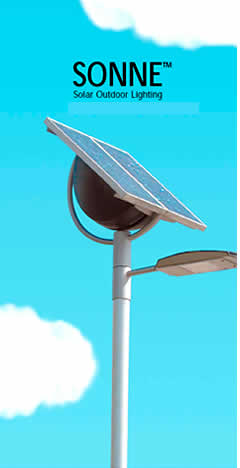NEWS ARTICLE ARCHIVESThe Sonne™ solar outdoor lamp from Se'Lux
Understanding how it works is easy. As the sun passes through its course of the day, sunlight rays strike upon one or more solar panels that are mounted above the light fixture. The rays stimulate silicon wafers contained within the solar panels that in turn output electricity which is stored in sealed gel batteries for later usage. Now that the sun's energy has been captured, its flow and storage must be precisely managed. Electrical current between the solar panels and the batteries, and between the batteries and the lamp is regulated by a built in device known as the Smart Controller. The Smart Controller detects when the batteries are fully charged, in which instance it would stop current flowing to them from the panels to prevent overcharging. It also senses and remembers when nightfall and sunrise occur, and it may be set to power the lamp for user-adjustable periods of time in relation to dawn and dusk. For instance, the Smart Controller could be set so that the light shines continuously from dusk to dawn, or alternatively it could be set to turn the lamp on for three hours after dusk, and again for one hour before dawn.
What's it made of?
Fixture Head
Smart Controller
Batteries
Battery Cover
Access Cover
Vandal Resistant Plating
Why use it? Consider that there is a need for a light source at a location not directly on an existing power grid, and then figure the cost of supplying power to that area. Now consider being able to meet your lighting needs without the extra expense of supplying electricity to those areas. The cost of installing just 100 to 150 feet of underground cable or 400 feet of overhead lines renders Sonne™ solar power lighting cost effective right from the start. And with a very easy installation and the absence of any additional power costs, the savings just keep adding up! Installations might include any of the scenarios depicted below as well as in National Parks, remote parking lots, skiing areas, country homes, golf courses, boat landings, hiking trails, rest stops, disaster areas - the list of possibilities goes on and on. |
 |
 |
 How does it work?
How does it work?